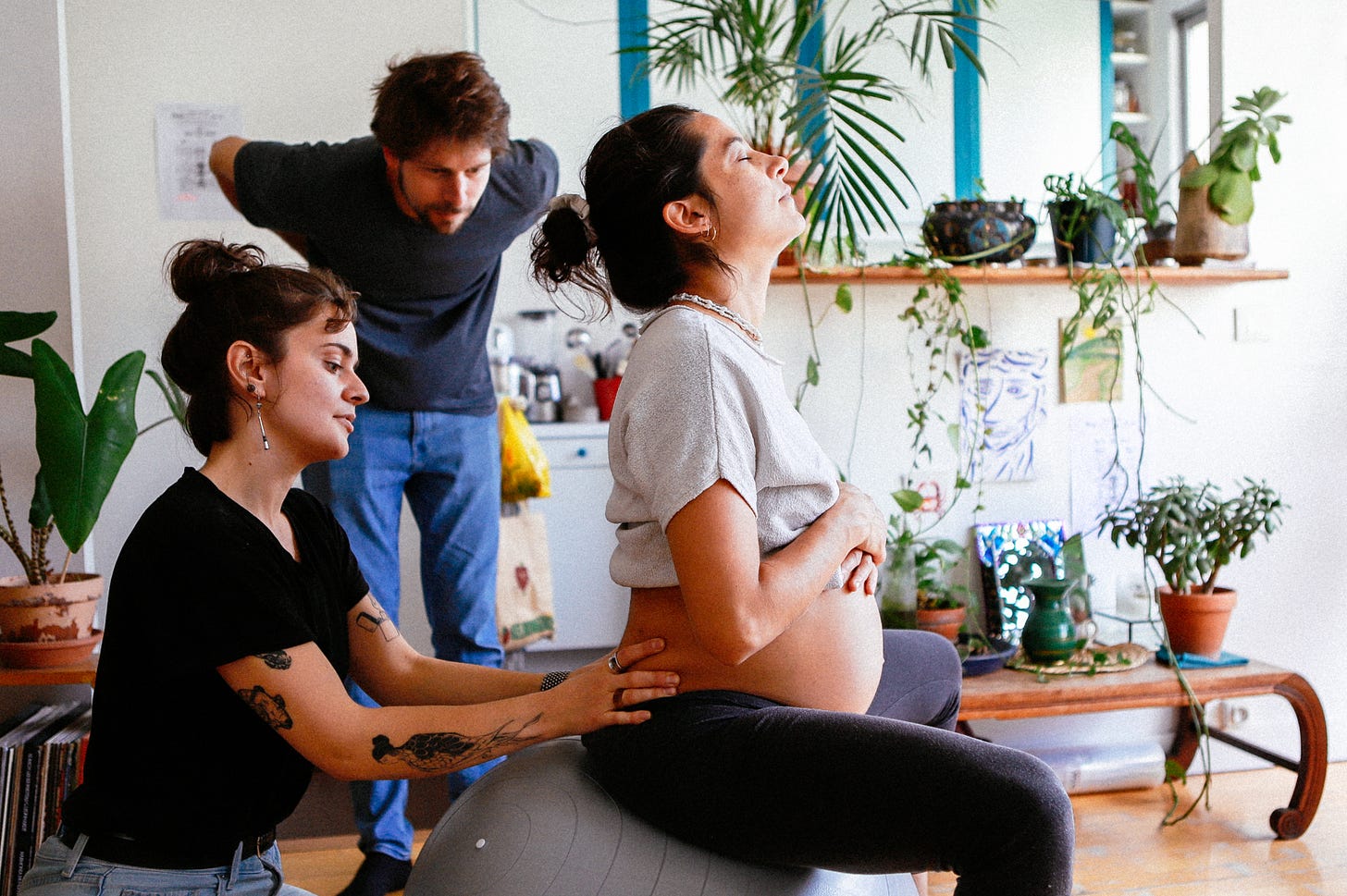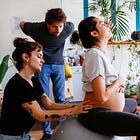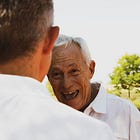Birth, revisited: the power of reproductive justice
A conversation with Eva-Luna Tholance
Eva-Luna Tholance is a doula, queer feminist activist, and journalist specialised in sexual health and medical violence. She co-edited the collective volume Coming into the World: Autonomy, Dignity, and Struggles for Reproductive Justice, [in French, not yet translated] published in September.
In this interview for The Fifth Wave Institute, she reflects on her journey to becoming a doula, the need to change our perceptions of parenthood, and the transformative power of a philosophy of care rooted in reproductive justice.
This interview is the second in our inaugural series on perinatal care. You can find the first one here.
To read this article in French:
How did you come to work on reproductive justice?
I started with activism. I was part of a collective focused on menstruation and endometriosis awareness, which gradually expanded its work to sexual and reproductive health. I also wrote about these issues as a journalist.
I first encountered the reproductive justice movement through Amandine Gay, a French Afrofeminist filmmaker and writer, and then Alana Apfel’s Birth Work as Care Work: Stories from Activist Birth Communities. It’s a stunning book that explores the central role of midwives and doulas in shaping an alternative vision of birth.
I had never heard the word “doula” before, nor the concept of reproductive justice. It was a revelation. It perfectly encapsulated the role I wanted to play in my community and in society: providing care, engaging with the medical world yet fighting obstetric violence, humanising patient experiences — all while steeped in the militant and feminist legacy of birth work.
I looked into becoming a doula but hesitated: I felt illegitimate. I was 22, and thought one needed to have had children to support others through perinatal experiences. But that’s not true. A friend preparing for IVF asked me to be her doula, and that pushed me to train. There were very few training programs in France at the time, so I enrolled online with Birthing Advocacy.
It was incredible—a second political awakening. The school was founded by Sabia Wade, a Black queer American activist, so the courses were deeply rooted in reproductive justice, with a queer and decolonial approach to doula work. It’s a political school as much as a practical one: the first lessons cover antiracism and queerness in perinatal care, and obstetric violence. Their philosophy isn’t just to train competent doulas, but “active partners in the movement to transform birth and reproduction.”
I began with postpartum training, then ‘full-spectrum’ training1, supplemented by specialised courses on childbirth preparation, disability, mental health, and abortion. The only one I haven’t yet completed is on supporting people with histories of addiction, which I’m eager to do, especially since it’s a significant issue in the queer community.
Your work focuses particularly on LGBTI individuals, survivors of sexual and domestic violence, and those whose bodies have been “pathologised and harmed by the medical industry.” As a care professional, how do you address their distrust of the medical world?
My support complements, not opposes, the medical system. I’ve attended prenatal appointments and hospital births, including C-sections. I am not against medicalised birth as such; my work is about preventing abuse and violence.
During preparation, we discuss different scenarios and how to respond: What’s a routine intervention? How does a cascade of interventions happen? What constitutes medical violence, and how do you confront it? Often, we dedicate a session to the birth plan, clarifying in advance which interventions are welcome and which are not. I also teach self-defense and co-defense techniques. Ultimately, we focus on how to make a space for oneself in the medical system, how to be heard.
Let’s talk about Coming into the world, which you co-edited with Johanna-Soraya Benamrouche. It’s structured around the three pillars of reproductive justice, as defined by the SisterSong collective in the 1990s:
“The right not to have children, through abortion, sterilisation, contraception, or choosing never to have them.
The right to have children when and how we want, and to give birth under the conditions we choose.
The right to raise children in safe, fulfilling environments, free from violence and environmental harm.”2
How does the concept of reproductive justice expand on the more commonly used ‘reproductive rights’?
It emphasises that rights alone aren’t enough. It adds an intersectional lens—antiracist, decolonial, queer. SisterSong’s core insight was that a right taken for granted by middle-class white women doesn’t necessarily mean justice for others. While women in mainland France fought for abortion rights, for example, many women in La Réunion were still subjected to forced sterilisation and coerced abortions.
Structural obstacles, systemic discrimination, and material barriers often prevent people from fully exercising their rights. French patients’ rights law, for example, guarantees informed consent, interpretation services, and the right to have a support person present at all times—but these are unevenly applied.
And finally, rights can always be revoked, as we’re seeing unfold in the United States.
In the intro to the book, you cite activist and poet Malkia Cyril:
“Right-wing movements have invested in culture wars, often led by women portrayed in the media as spokespeople for conservative visions of family, work, and the economy—vehement opponents of migrant rights and restorative justice. Conservative organisations have cultivated a generation of anti-feminist female leaders who continue to redefine feminism and motherhood in their most destructive, hierarchical forms. By underestimating their impact and failing to invest in cultural and communication strategies that center the voices of marginalised mothers, progressive movements have weakened themselves.”
This resonates with a central thesis behind the creation of The Fifth Wave: that faced with the co-optation of natality, parenthood, and family, it is vital to shed greater light on feminist and research-based perspectives on those issues.
One such perspective highlighted in the book comes from the founders of La Bulle, a collective which sets up child-friendly spaces at activist events so parents can participate. They critique the portrayal of parenthood as “dull, exhausting, and boring,” in contrast to the “cool” freedom of non-parenthood — a binary, dogmatic narrative that often goes unchallenged even in supposedly subversive circles. It refuses to acknowledge parenthood as a rich, intellectually and emotionally profound experience, often out of a legitimate fear of reinforcing the injunction leveraged at women to become mothers.
This narrative also erases the historical role of parents, especially mothers, in revolts and uprisings — and their ongoing activism. In France, for example, ethnic minority mothers have been at the forefront of denouncing violence and discrimination against their children, as have many parents fighting against child abuse.
How do we change this reductive perception of parenthood?
Precisely through initiatives like La Bulle: by creating truly intergenerational spaces, by including children and parents in our movements and our thinking. By considering parenting as deserving of as much nuanced and complex attention as other experiences.
We do it by showing that children’s rights are radical struggles, that the fight against childism3 is fundamental to building a society that stops crushing the most vulnerable. We also need to reject the idea that the only voices advocating for children are those opposing comprehensive sex education or trans children’s rights.
Reproductive justice also helps to reclaim parenthood by confronting the ways the concept of family has been frozen in whiteness and heteronormativity. This means addressing uncomfortable truths: the reproductive barriers placed on people of colour, the criminalisation of their families, the historical exclusion of queer people from family-making. It’s about showing that family can mean a thousand things.
You offer specialised support for people undergoing abortions. In the book, you write that “of all perinatal experiences, abortion is the most solitary.” Why?
The discourse around abortion is just as binary as that around parenthood, leaving little room for nuance. On one side, it’s framed as liberating and feminist—asking for help is seen as admitting failure. On the other, it’s assumed to be inherently traumatic, shameful, and taboo. In reality, it’s usually somewhere in between. People are often relieved because they didn’t want or weren’t capable of welcoming a child, but also sad if they had envisioned themselves as parents. And no one is safe from feeling shame and guilt.
This is experienced in isolation, especially among young people: few ask friends to support them during a medical abortion. It happens in private, unlike surgical terminations where a midwife or healthcare provider can be present. With medical abortion, you’re alone in your living room, unprepared for the physical symptoms, the bleeding, the pain—with only a prescription for paracetamol. I’ve heard many stories of people thinking they were dying because they hadn’t been warned of what to expect.
The book mentions that doulas in France are monitored by Miviludes, the government agency combating sectarian tendencies. Is this rooted in genuine concern or resistance to the autonomisation of birth?
Both.
The skepticism isn’t baseless: in 2008, Françoise Souverville, a Franco-American who worked as a midwife in the U.S., moved to France. Her degree wasn’t valid here, so she became a doula and attended unassisted births4. A baby died during one of these home births. She was sentenced to 18 months in prison for illegal practice of medicine and involuntary manslaughter.
After that, doulas were especially scrutinised, catapulted into the public eye as women who deliver babies in the woods, a bit witchy, shamanistic. And there is definitely some truth to that: some incorporate the whole “divine feminine” thing into their practice, some sell overpriced energy healing products and supplements. All the new age elements you find online can seep into the profession.
But most doulas do rigorous, ethical work. And that work doesn’t always sit well with the medical establishment: we’re present in delivery rooms, we know patients’ rights, we encourage questions. Not to slow things down pointlessly, but to ensure birth plans and informed consent are respected—rights guaranteed by law. In a system that prioritises speed, this is disruptive.
I’ve learned to defuse potential tensions. When I intervene, I always address my clients: “Do you understand everything? How are you feeling? Do you want to take five minutes?” I’m not the center; I won’t create conflict where there isn’t any.
The book stresses the importance of comparing maternity ward practices when planning for birth, as levels of medicalisation and respect for autonomy vary. How can we improve national frameworks for more humane perinatal care and greater reproductive justice, regardless of where someone gives birth?
Laws have limited reach. They can’t, and shouldn’t, dictate every aspect of private life or professional practice. But there’s much to be done regarding the training healthcare providers receive. For example, normalising the use and respect of birth plans as serious documents — they aren’t a Christmas wishlist.
The shift can’t be exclusively top-down; our entire philosophy of care must evolve. We need a more human, person-centered, inclusive approach and a broader definition of a ‘good birth’. Does ‘it went well’ just mean ‘mum and baby are alive and healthy’, or does it account for the fact that both feel emotionally secure, and aren’t traumatised?
Today, care is performance-driven. Many providers are paid per procedure and thus push certain interventions, like epidurals, even when unnecessary. Some anesthesiologists resort to threats during prenatal visits: “If you don’t take the epidural when offered, I won’t come back when you need me.”
It’s a system that exhausts both providers and patients—but the latter still bear the brunt of medical violence.
The book includes an ecofeminist angle, with an article by the Vietnam-Dioxin Collective on the impact of Agent Orange on pregnancies and fertility. You also discuss your investigation into the link between tear gas, reproductive disorders, and miscarriages. How did you conduct it?
During France’s 2021 protests against a controversial security bill, my partner always had painful periods afterward. She came across a post by Gina Martinez, founder of the Colorado Doula Project, who had researched the issue. I realised there was extensive global documentation, especially from Black Lives Matter, but little in France. I put out a call for testimonies on Instagram and interviewed Martinez and Rohini Haar, a member of Physicians for Human Rights and co-author of a report on tear gas use in Bahrain. That became my first article.
After each Saturday protest, I repeated the call. I gathered about a hundred testimonies from people with a variety of backgrounds. Many reported the same symptoms at the same point in their cycles, even while on testosterone, birth control, or in perimenopause. It’s self-reported, but it’s the most ethical scientific method available—you can’t expose pregnant women to tear gas for a study. This approach was later used in a U.S. epidemiological study on the same topic.
Despite this data, building a legal case would be difficult. The miscarriage stories shared with me weren’t medically documented—only one participant who miscarried following a protest saw a gynecologist, but she hadn’t yet made the connection with tear gas. Gathering sufficient evidence would require many people to have the information, energy, and willpower to get blood tests immediately after a miscarriage.
One of The Fifth Wave Institute’s missions is to highlight initiatives shaping the futures of care. Do you have one in mind that advances reproductive justice?
The Observatoire féministe des violences médicales (Feminist Medical Violence Observatory). It was founded in 2024 by Johanna-Soraya Benhamrouche and Tsippora Sidibé after the death of Aïcha, a 13-year-old Black girl who died after being accused of faking her symptoms by emergency responders. I sit on their advisory board.
It’s a fantastic organisation working to change minds and practices through advocacy, victim support, and training for providers and patients in respectful care. They just launched a campaign to display patients’ rights in waiting rooms, with downloadable posters in multiple languages.
Initiatives like this give me hope for the future of reproductive justice. I trust the people doing this crucial work and my doula colleagues who offer beautiful support.
Finally: Who do you care for, and who cares for you?
I care for my clients, my friends (I hope), and my partner. And he cares for me.
Further reading:
Training to support the full panel of perinatal experiences: infertility, pregnancy, abortion, loss, adoption, postpartum.
Eva-Luna Tholance & Johanna-Soraya Benhamrouche (eds.), 2025. Venir au Monde: Autonomie, dignité et luttes pour une justice reproductive. Éditions trouble. A fourth axis, which permeates the whole book, focuses on “bodily autonomy, including medical autonomy, the right of movement and return, the right to transition, the right to dignity in all circumstances, even during old age and death.”
Or for childism – depending on the context, the term confusingly means either prejudice against children or the fight against that prejudice
At-home births unassisted by a midwife.





